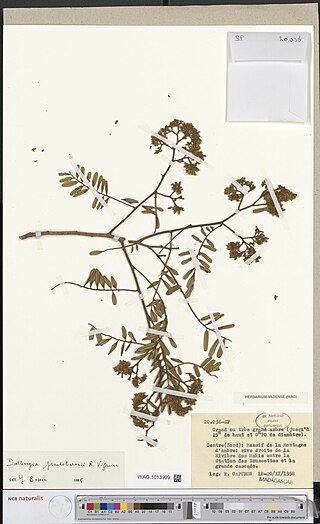Dalbergia baronii is a species of flowering plant in the legume family Fabaceae. It is endemic to Madagascar. It is named after the English missionary and botanist Rev. Richard Baron.
Dalbergia chlorocarpa is a species of legume in the family Fabaceae. It is found only in Madagascar. It is threatened by habitat loss.
Dalbergia davidii is a species of legume in the family Fabaceae. It is found only in Madagascar.
Dalbergia glaberrima is a species of legume in the family Fabaceae. It is found only in Madagascar.
Dalbergia humbertii is a species of legume in the family Fabaceae. It is found only in Madagascar.
Dalbergia lemurica is a species of legume in the family Fabaceae. It is found only in Madagascar. It is threatened by habitat loss.

Dalbergia madagascariensis is a species of legume in the family Fabaceae. It is found only in Madagascar. It is threatened by habitat loss.
Dalbergia monticola is a species of flowering plant in the legume family Fabaceae. It is endemic to Madagascar. It occurs at higher elevation, which gave the species its name.
Dalbergia neoperrieri is a species of legume in the family Fabaceae. It is found only in Madagascar. It is threatened by habitat loss.

Dalbergia peltieri is a species of legume in the family Fabaceae. It is found only in Madagascar. It is threatened by habitat loss.

Dalbergia pseudobaronii is a species of flowering plant in the legume family Fabaceae. It is endemic to Madagascar. Its leaves are similar to those of Dalbergia baronii, which gave the species its name.

Dalbergia purpurascens is a species of legume in the family Fabaceae.
Dalbergia suaresensis is a species of legume in the family Fabaceae, and is unique because it is only found in Madagascar. The plant's conservation status is listed as "endangered", and its continued existence on this planet is threatened by habitat loss.

Dalbergia tricolor is a species of legume in the family Fabaceae. It is found only in Madagascar. It is threatened by habitat loss.
Dalbergia tsiandalana is a species of legume in the family Fabaceae. It is found only in Madagascar. It is threatened by habitat loss.
Dalbergia urschii is a species of legume in the family Fabaceae. It is found only in Madagascar. Trees of dalbergia urschii are often harvested for lumber, due to the high quality and unique color of its wood.
Dalbergia viguieri is a species of legume in the family Fabaceae. It is found only in Madagascar. It is threatened by habitat loss.

Dypsis pembana, also known as mpapindi or mpopo wa mwitu, is a species of plant in the family Arecaceae that is endemic to Tanzania.

Zombitse-Vohibasia is a national park in the Atsimo-Andrefana region of south-west Madagascar. It is 147 kilometres (91 mi) north-east of the town of Toliara on the National road 7.
Zanha golungensis, commonly known as the smooth-fruited zanha, is a species of plant in the family Sapindaceae that is native to Africa. It is used locally for timber and herbal medicine.







